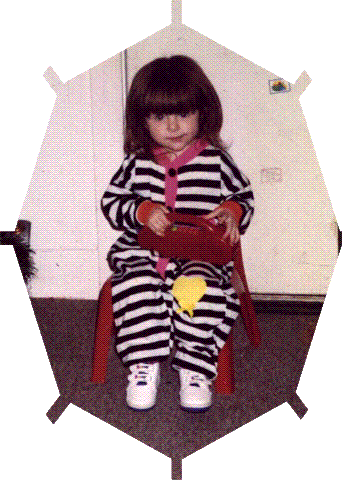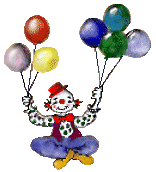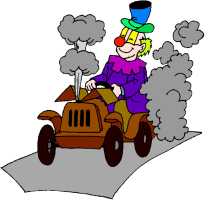
A Good Laugh
Goes a Long Way
 It Improves Circulation
It Improves Circulation
The heart works a little harder when you laugh
to move the blood and fluids around the body.
 It Increases Activity
in the Lungs
It Increases Activity
in the Lungs
That fast moving blood is richer in oxygen during laughter.
And the increased respiratory activity during laughter
helps to clean the lungs out.

It Lowers Blood Pressure
How long it stays lowered and how low it drops depends on
how long and how hard you laugh.
 It Releases Pain-Reducing
Hormones
It Releases Pain-Reducing
Hormones
The hormones, called catecholamines, decrease your perception
of pain. Just ask Norman Cousins, author of "Anatomy of an Illness,"
about the anesthetic effect of a good, long belly laugh.
 It Decreases Muscle Tension
It Decreases Muscle Tension
Most energy is drawn to the abdomen during laughter.
So the rest of your muscles relax. And less physical tension usually leads
to less emotional tension and stress.
 It Enhances Digestion
It Enhances Digestion
The increased activity produced by the laugh,
more blood and oxygen in the system, improves the digestion rate by massaging
the gastrointestinal system.
 It Lifts the Spirit
It Lifts the Spirit
Humor has the power to transport you out of the blues and
into a better state of mind. It opens lines of communication and allows
you to express a wide range of feelings. A smile
and a laugh can
communicate volumes.
-Source unknown

A Clown's
Prayer

As I stumble through this life,
help me to create more laughter than tears,
dispense more cheer than gloom,
spread more cheer than despair.
Never let me become so indifferent,
that I will fail to see the wonders in the eyes of a child,
or the twinkle in the eyes of the aged.
Never let me forget that my total effort is to cheer
people,
make them happy, and forget momentarily,
all the unpleasantness in their lives.
And in my final moment,
may I hear You whisper:
"When you made My people smile,
you made me smile."
Anonymous

Everyone loves a clown.
But does anyone know why or where they originated?
Clowns are comical characters who try to make others laugh. They dress in distinctive makeup and costumes and tend to perform a set routine involving graphic humor and absurd situations.
The first clown has been traced back to 3000 B.C.
The earliest known clowns were found in ancient Greece and were made up to look fat and bald. Such clowns were secondary characters in farces, often miming or parodying more serious characters. Sometimes they would throw nuts at the audience.
Similar clowns were found in Roman mime. These clowns wore a pointed hat and a colorful robe and were the main target for all the tricks and abuse of fellow actors.
During the Middle Ages, when traveling entertainers began to imitate the antics of court jesters and amateur fool societies, clowns began to emerge as professional comical characters. It was during this time that the Arlecchino, or Harlequin, clown was developed by traveling companies of the Italian commedia dellĠarte. This famous clown was originally a comical servant but eventually transformed into an acrobatic trickster. His attire included a black domino mask, and he would carry a bat or a slapstick to spank his victims.
William Kemp and Robert Armin, both English, were some of the first professional stage clowns associated with Shakespeare's company.
Traveling English actors introduced stage clowns to Germany. One of Germany's biggest clowns was Pickelherring, who wore a costume similar to those worn by contemporary clowns. It consisted of oversized shoes, waistcoats, hats and giant ruffles around the neck.
The bald-headed French clown Pierrot is said to have introduced whiteface makeup. He used flour to achieve the effect.
Joseph Grimaldi is known as "the father of modern
clowning." he was among the earliest circus clowns, appearing in England in 1805.
He specialized in physical tricks such as tumbling, pratfalls and slapstick beatings. In honor of Joseph Grimaldi's contributions to clowning, clowns
are known as "Joeys."

Modern clowns fall into one of three categories:
This clown wears a base of white grease paint on his face. Natural facial features like eyes, nose and cheeks are highlighted. His costume tends to match more than that of other clown types.
He usually acts serious in skits but falls prey to the punchline. Bozo the Clown is an example.
This clown has a tendency of being the silly clown. He appears to not know what is going on in the skit. His makeup is a bright flesh-tone base. Bright colors are used to exaggerate natural facial features. An example of this would be a large outline of the mouth.
His costume, also very bright, is mismatched. Auguste clowns wear primary colors a lot and most of the time the costume is oversized.
This is a character exaggerated into a clown. The hobo and tramp clowns are examples. Character trademark black makeup around the mouth like a beard.
Their costumes vary according to the type of character being portrayed.
Characters can be almost anything.
Emmett Kelly Jr. can be considered a character clown because he played a vagabond.
For more information about Emmett Kelly Jr. and his clown colleagues, visit the site at www.webdom.com/chof.
In clowning, there is a hierarchy, with the White Face clown at
the high end and he hobo at the low end. Because of this understood hierarchy, an Auguste
clown can never play a trick on a White Face clown, but a white face clown can play a
trick on anybody.
A clown's face is his/her trademark, which cannot be copied by
any other clown. The clothes and act of a clown, however, can be imitated.
To trademark a clown face, clowns send a photo of their face
into the Clown and Character Registry, where the face is then painted on a goose egg and
kept in the registry
The tradition of painting the clown face on a goose egg dates
back to the 1500s when clowns would paint their face on an egg so they would remember what
the face looked like.
In Russia, clowns are looked up to with the same prestige that
ballerinas or pianists enjoy. In fact, clowns must go to the Moscow State Circus College
for Circus and Variety Arts for seven years in order to join the Moscow State Circus.
In the United States, clown hopefuls attend the Ringling
Brothers/Barnum and Bailey College in Baraboo, Wis., for two months.
There are between 50,000 and 80,000 clowns in the world today. Bozo the Clown wears size 83AAA shoes.
Source of clown trivia: Clown Hall of Fame and Research Center,
Delavan, Wis., and from the Clown Hall of Fame Web site.
Visit Our Underwater Sea World
EMAIL:
Clowns 4 Jesus
FUNNY CLOWNS ANIMATION



Enchanted Forest "Glade" Community Center
~ Full of Clown Fun & Clown Backgrounds!.
Sweet Azalea's Birthday Fun & Clowns
Servants of the Savior (SOS) Clowns

~ The End ~



Set May 16, 1999